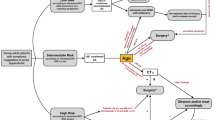Abstract
Purpose
This study was undertaken to evaluate the accuracy of contrast-enhanced ultrasound (CEUS) in the detection and grading of abdominal traumatic lesions in patients with low-energy isolated abdominal trauma in comparison with baseline ultrasound (US) and contrast-enhanced multidetector computed tomography (CE-MDCT), considered the gold standard.
Materials and methods
A total of 256 consecutive patients who arrived in our Emergency Department between January 2006 and December 2012 (159 males and 97 females aged 7–82 years; mean age 41 years), with a history of low-energy isolated abdominal trauma were retrospectively analysed. All patients underwent US, CEUS with the use of a second-generation contrast agent (Sonovue, Bracco, Milan, Italy) and MDCT. Sensitivity, specificity, positive and negative predictive values (PPV and NPV) and overall accuracy for the detection of lesions and free peritoneal fluid on US and CEUS, and sensitivity for the grading of lesions on CEUS were calculated compared with the CT findings, in accordance with the American Association for the Surgery of Trauma criteria.
Results
CE-MDCT identified 84 abdominal traumatic lesions (liver = 28, spleen = 35, kidney = 21) and 45 cases of free intraperitoneal fluid. US depicted 50/84 traumatic lesions and 41/45 cases of free peritoneal fluid; CEUS identified 81/84 traumatic lesions and 41/45 free peritoneal fluid. The sensitivity, specificity, PPV, NPV and overall accuracy for the identification of traumatic abdominal lesions were 59, 99, 98, 83 and 86 %, respectively, for US and 96, 99, 98, 98 and 98 %, respectively, for CEUS. The values for the identification of haemoperitoneum were 91, 99, 95, 98 and 97 %, respectively, for US and 95, 99, 95, 99 and 98 %, respectively, for CEUS. CEUS successfully staged 72/81 traumatic lesions with a sensitivity of 88 %.
Conclusions
In patients with low-energy isolated abdominal trauma US should be replaced by CEUS as the first-line approach, as it shows a high sensitivity both in lesion detection and grading. CE-MDCT must always be performed in CEUS-positive patients to exclude active bleeding and urinomas.







Similar content being viewed by others
References
Poletti PA, Wintermark M, Schneyder P et al (2002) Traumatic injuries: role of imaging in the management of the polytrauma victim (conservative expectation). Eur Radiol 12:969–978
Valentino M, Ansaloni L, Catena F et al (2009) Contrast-enhanced ultrasonography in blunt abdominal trauma: considerations after 5 years of experience. Rad Med 114:1080–1093
Catalano O, Aiani L, Barozzi L et al (2009) CEUS in abdominal trauma: multi-center study. Abdom Imaging 34:225–234
Clevert DA, Weckbach S, Minaifar N et al (2008) Contrast-enhanced ultrasound versus MS-CT in blunt abdominal trauma. Clin Hemorheol Microcircul 39:155–169
Lv F, Tang J, Luo Y et al (2011) Contrast-enhanced ultrasound imaging of active bleeding associated with hepatic and splenic trauma. Radiol Med 116:1076–1082
Miele V, Buffa V, Stasolla A et al (2004) Contrast-enhanced ultrasound with second generation contrast agent in traumatic liver lesions. Radiol Med 108:82–91
Regine G, Atzori M, Miele V et al (2007) Second-generation sonographic contrast agents in the evaluation of renal trauma. Radiol Med 112:581–587
Oldenburg A, Hohmann J, Skrok J et al (2004) Imaging of paediatric splenic injury with contrast-enhanced ultrasonography. Pediatric Radiol 34:351–354
Cokkinos D, Antypa E, Stefanidis K et al (2012) Contrast-enhanced ultrasound for imaging blunt abdominal trauma—indications, description of the technique and imaging review. Ultraschall Med 33:60–67
Afaq A, Harvey C, Aldin Z et al (2012) Contrast-enhanced ultrasound in abdominal trauma. Eur J Emerg Med 19:140–145
Moore EE, Cogbill TH, Jurkovich GJ et al (1995) Organ injury scaling: spleen and liver (1994 revision). J Trauma 38:323–324
Moore EE, Shackford SR, Pachter HL et al (1989) Organ injury scaling: spleen, liver and kidney. J Trauma 29:1664–1666
Valentino M, Serra C, Zironi G et al (2006) Blunt abdominal trauma: emergency contrast-enhanced sonography for detection of solid organ injuries. AJR Am J Roentgenol 186:1361–1367
Catalano O, Lobianco R, Raso MM, Siani A (2005) Blunt hepatic trauma: evaluation with contrast-enhanced sonography: sonographic findings and clinical application. J Ultrasound Med 24:299–310
Catalano O, Cusati B, Nunziata A, Siani A (2006) Active abdominal bleeding: contrast-enhanced sonography. Abdom Imaging 31:9–16
Marmery H, Shanmuganatan K, Mirvis SE et al (2008) Correlation of multidetector CT findings with splenic arteriography and surgery: prospective study in 392 patients. J Am Coll Surg 206:685–693
Hamilton JD, Kumaravel M, Censullo ML et al (2008) Multidetector CT evaluation of active extravasation in blunt abdominal and pelvic trauma patients. Radiographics 28:1603–1616
Valentino M, De Luca C, Galloni SS et al (2010) Contrast-enhanced US evaluation in patients with blunt abdominal trauma. J Ultrasound 13:22–27
Tang J, Li W, Lv F et al (2009) Comparison of gray-scale contrast-enhanced ultrasonography with contrast-enhanced computed tomography in different grading of blunt hepatic and splenic trauma: an animal experiment. Ultrasound Med Biol 35:566–575
Dietrich CF (2008) Comments and illustrations regarding the guidelines and good clinical practice recommendations for contrast-enhanced ultrasound (CEUS)–update 2008. Ultraschall Med 29(Suppl 4):S188–S202
Clevert DA, Weckbach S, Minaifar N et al (2008) Contrast-enhanced ultrasound versus MS-CT in blunt abdominal trauma. Clin Hemorheol Microcirc 39:155–169
Pinto F, Miele V, Scaglione M, Pinto A (2013) The use of contrast-enhanced ultrasound in blunt abdominal trauma: advantages and limitations. Acta Radiol. doi:10.1177/0284185113505517
Conflict of interest
The authors declare no conflict of interest.
Author information
Authors and Affiliations
Corresponding author
Rights and permissions
About this article
Cite this article
Sessa, B., Trinci, M., Ianniello, S. et al. Blunt abdominal trauma: role of contrast-enhanced ultrasound (CEUS) in the detection and staging of abdominal traumatic lesions compared to US and CE-MDCT. Radiol med 120, 180–189 (2015). https://doi.org/10.1007/s11547-014-0425-9
Received:
Accepted:
Published:
Issue Date:
DOI: https://doi.org/10.1007/s11547-014-0425-9




